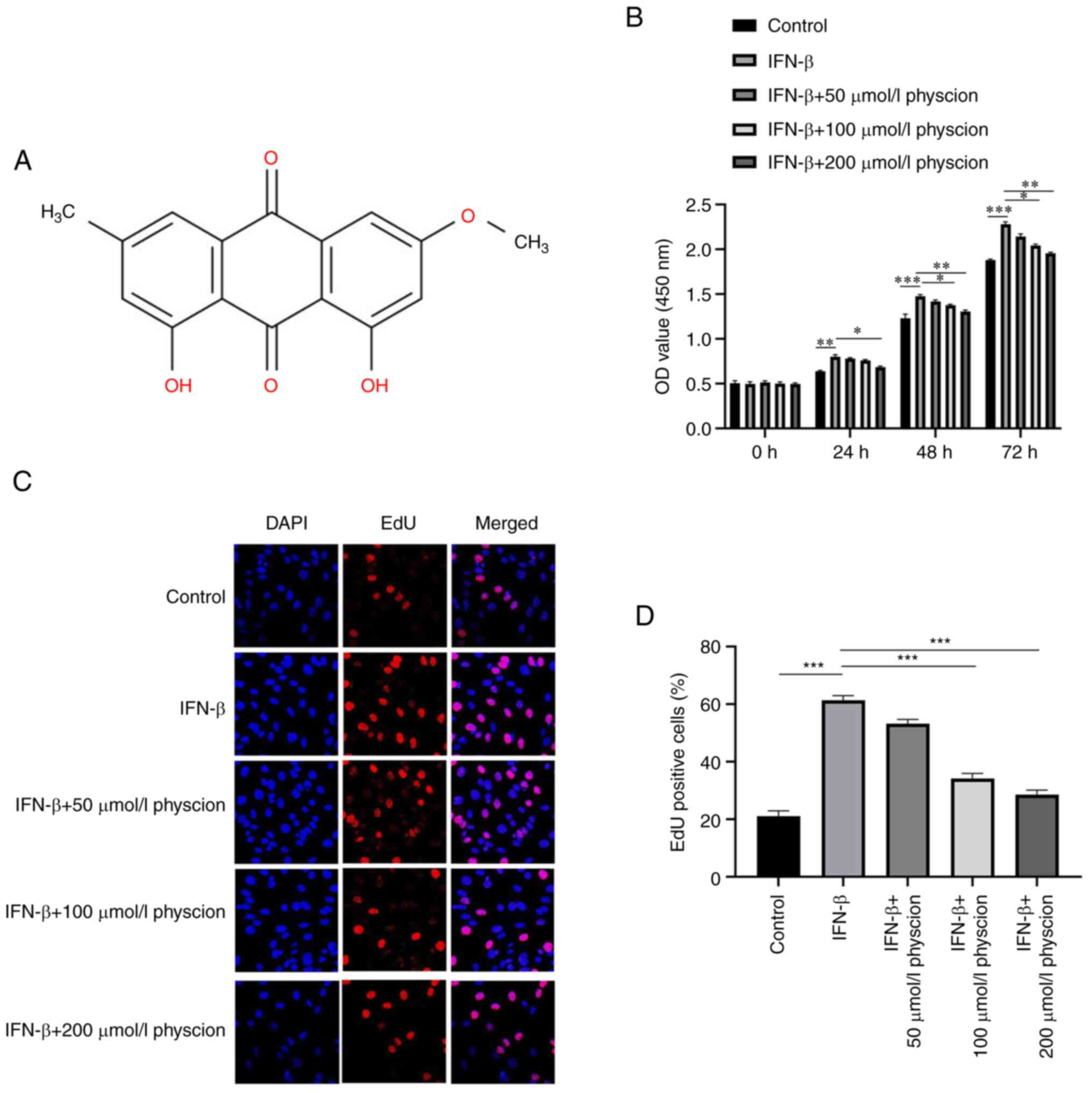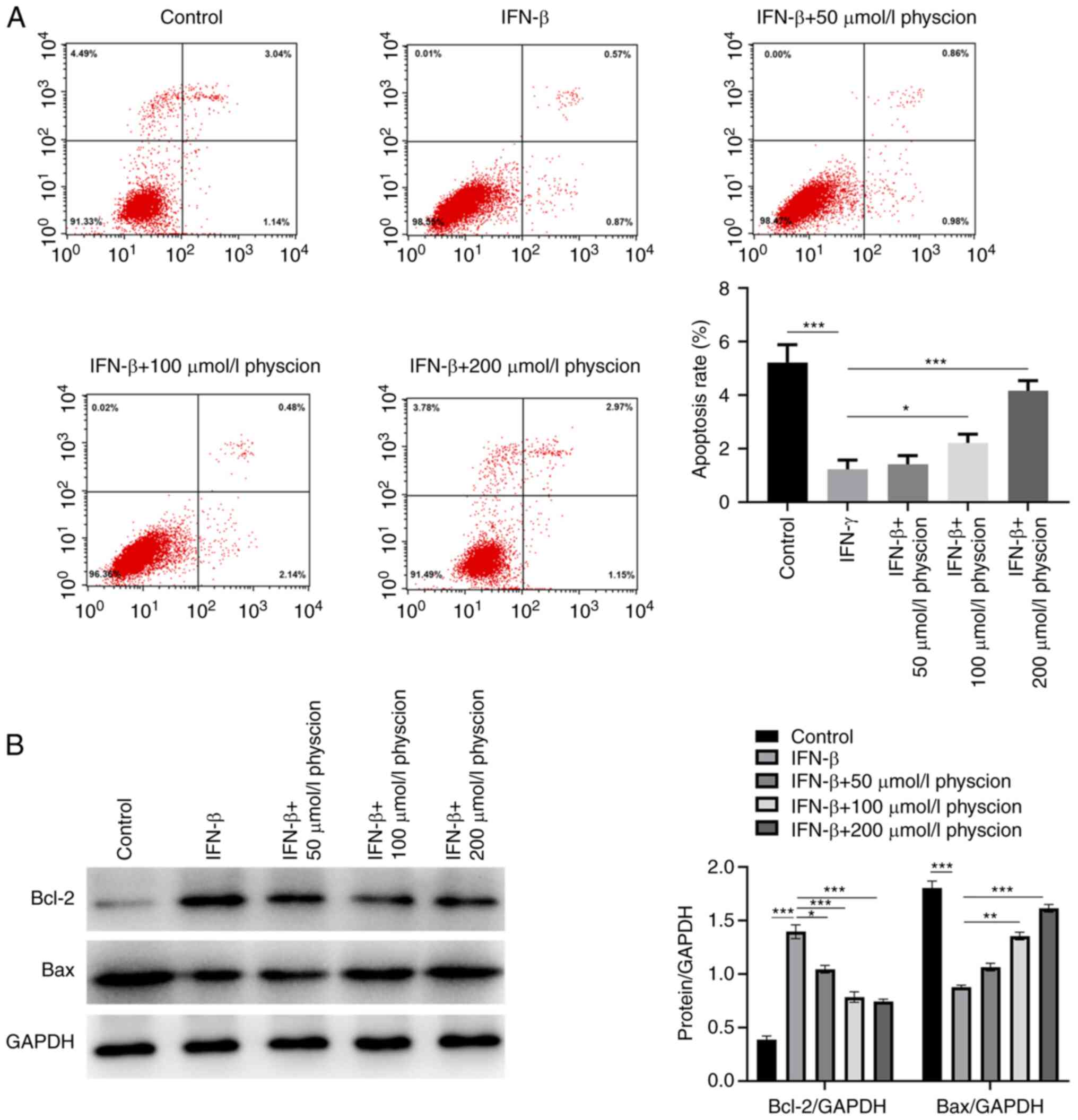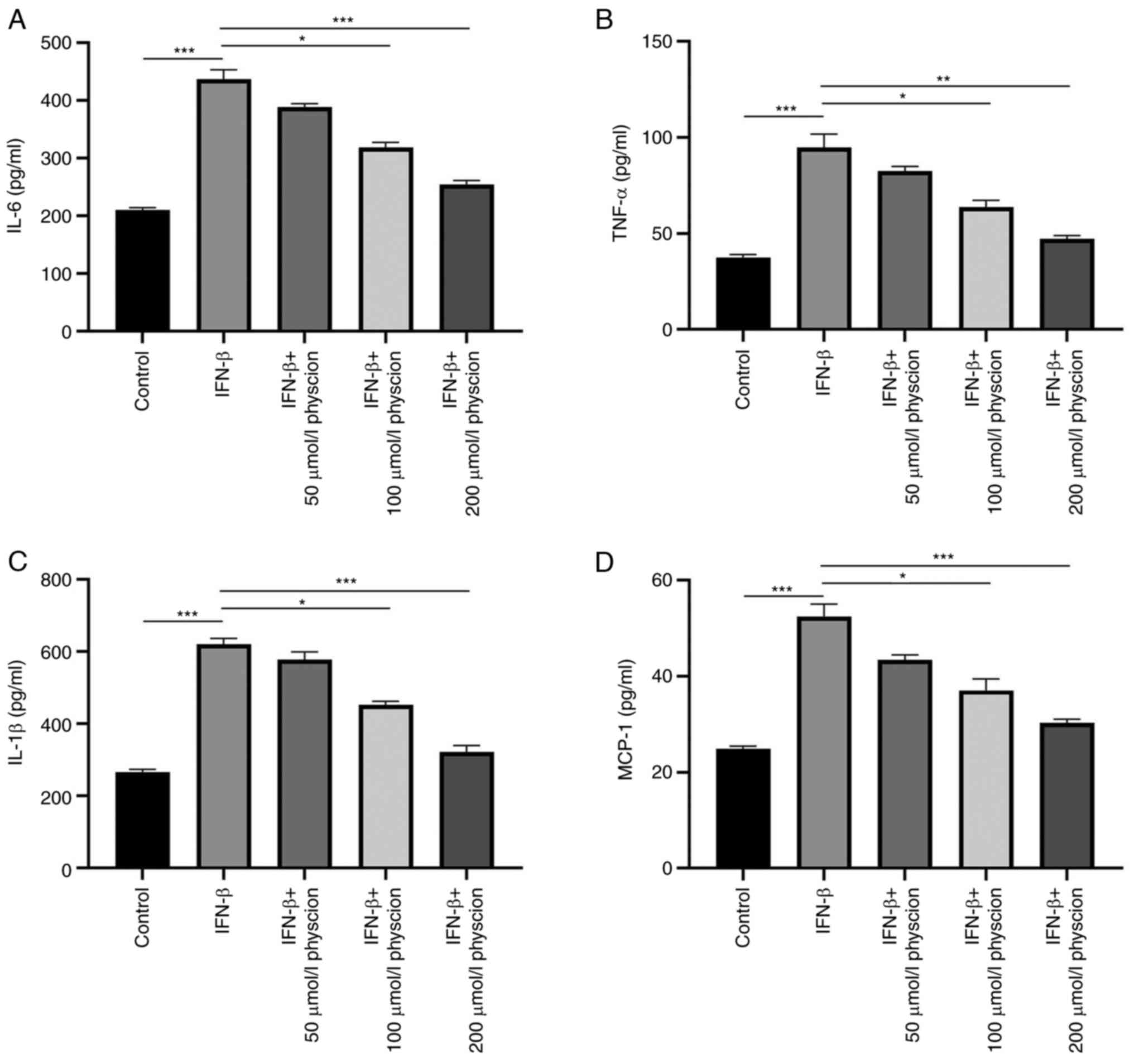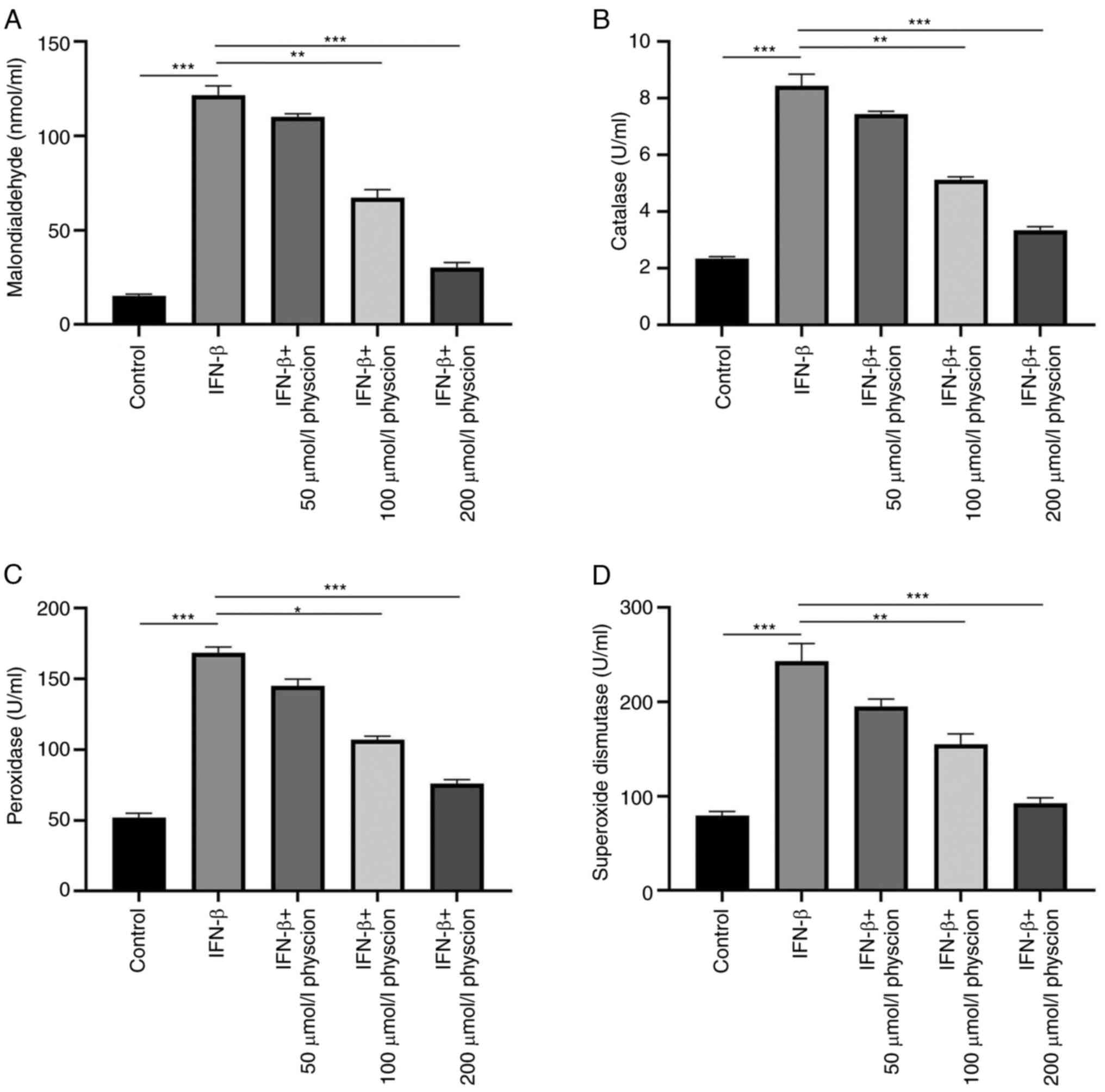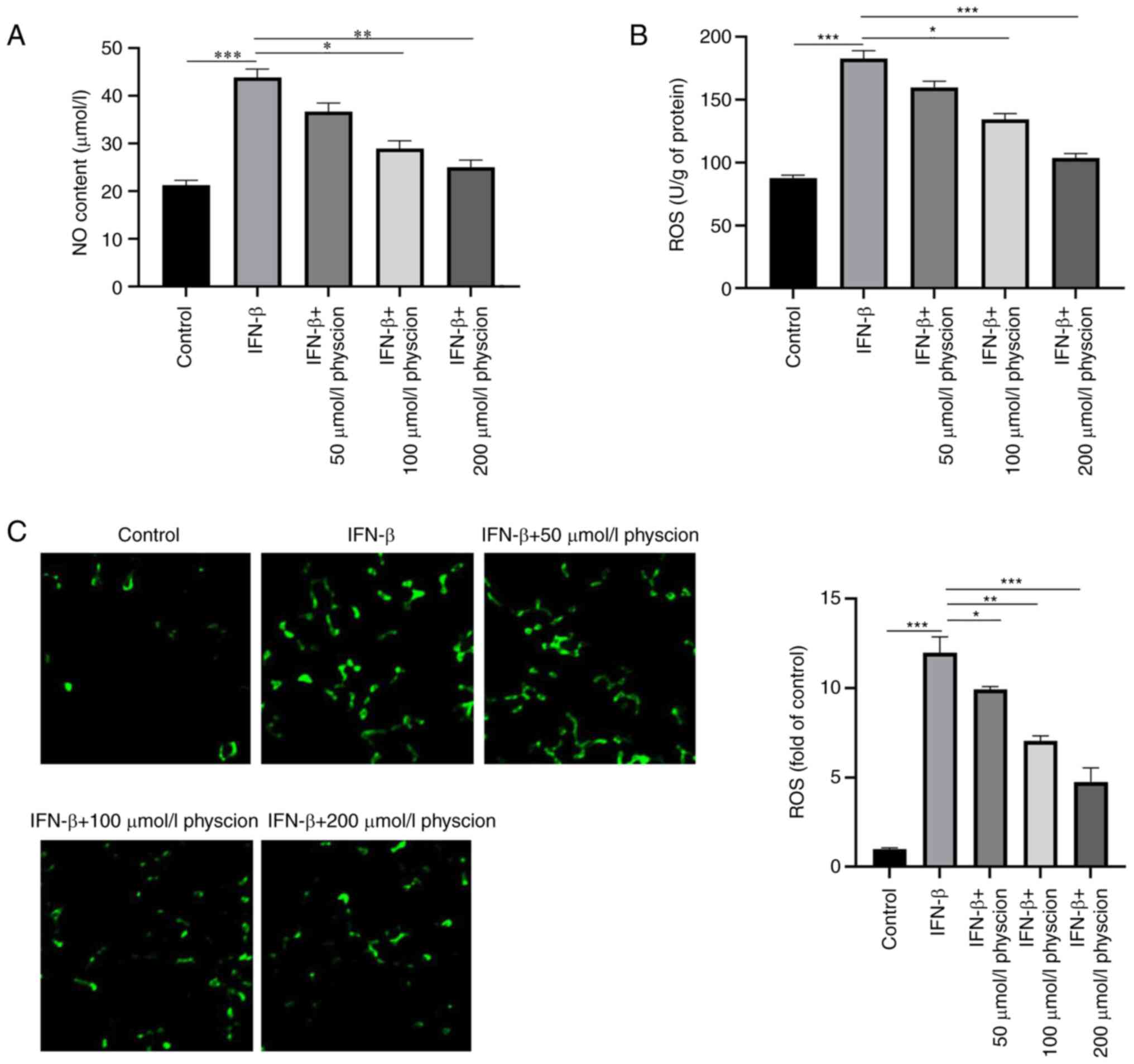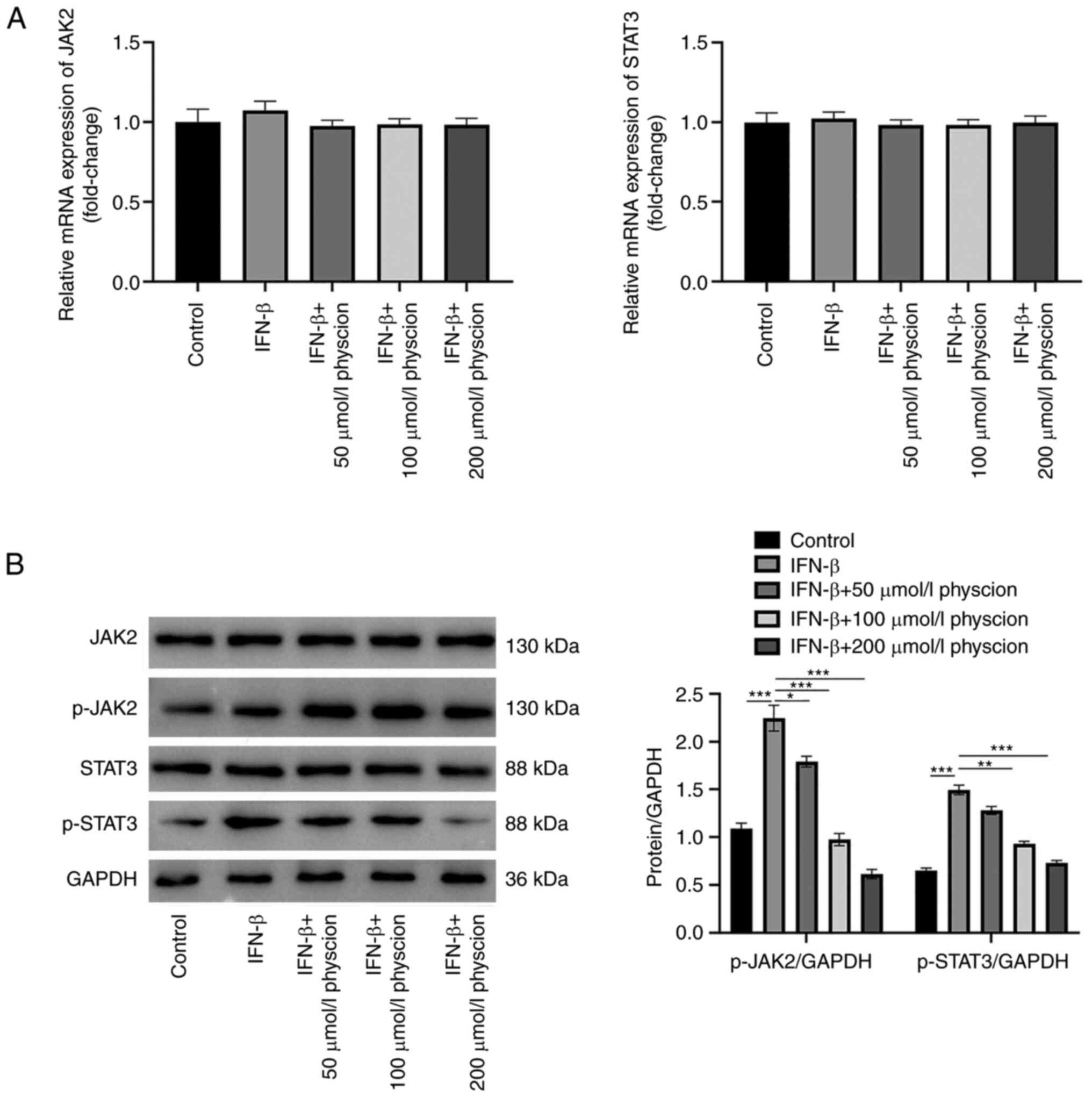Physcion prevents induction of optic nerve injury in rats via inhibition of the JAK2/STAT3 pathway
- Authors:
- Published online on: June 26, 2023 https://doi.org/10.3892/etm.2023.12080
- Article Number: 381
-
Copyright: © Li et al. This is an open access article distributed under the terms of Creative Commons Attribution License.
Abstract
Introduction
The optic nerve is generated by various axons of retinal ganglion cells (RGCs) located at the back of the eyeball (1). Optic nerve injury, including glaucoma, is a type of neurodegenerative disease that occurs in the eye (2). Degeneration, necrosis and apoptosis of RGCs and their axons are the pathological causes of visual impairment following optic nerve injury (3). The main direct result of optic nerve injury is the demise of RCGs, leading to blindness due to the inability of neuronal regeneration (4). Therefore, it is essential to explore novel methods to ameliorate the therapeutic efficacy of current therapies for the treatment of optic nerve injury.
The Janus kinase (JAK)/STAT signaling pathway is a common pathway of various cytokine signal transductions, which is involved in cell proliferation, apoptosis, inflammation and other processes (5). The activation of the JAK/STAT pathway requires an extracellular ligand to bind to a transmembrane receptor, leading to the activation of the receptor-related JAKs. Subsequently, phosphorylated (p) tyrosine kinases and their related receptors provide docking sites to the STAT transcription factors (6). STATs translocate to the nucleus and control the expression levels of certain target genes (7). The activation of the JAK/STAT pathway promotes the progression of various diseases (8). Concomitantly, activation of the JAK/STAT pathway is linked to the occurrence of various neurological diseases (9). For instance, overexpression of p-JAK and p-STAT induced by inflammatory factors takes part in the pathogenesis of depression (10). In addition, during neuroinflammation and in certain degenerative diseases, inhibition of abnormal activation of the JAK/STAT pathway is involved in ameliorating and attenuating the disease symptoms (11). A previous study found that JAK inhibitors could be an effective clinical treatment for patients with Parkinson's disease (12).
The Cassia seed, also named ‘Juemingzi’ in Chinese, belongs to the Cassia genus of Leguminosae (13). At present, the majority of the studies mainly focused on anthraquinone compounds present in Cassia seeds, which can be divided into free and conjugated anthraquinones, including hesperidin, chrysophanol, emoin methyl ether and aloe emoin (14). Physcion is its main anthraquinone component and has a wide range of pharmacological effects; moreover, when administered orally, it was shown to be essentially non-toxic and able to cross the blood-brain barrier (15). Previous studies on the neuroprotective effects of physcion have mainly focused on the prevention of ischemia, hypoxia and ischemia-reperfusion brain injury (16). However, the effects of physcion on optic nerve injury remain unclear.
The present study aimed to explore the possible mechanism of physcion in alleviating microglia overactivation and inflammatory response in rats with optic nerve injury. The results may provide a new theoretical basis for clinical studies which aim to examine the pathological mechanism and clinical treatment of optic nerve injury.
Materials and methods
Cell culture and treatment
Rat HAPI microglial cell lines were purchased from Shenzhen HaodiHuatuo Biological Technology Co., Ltd., and by DNA species identification it was confirmed that the present HAPI cell line was derived from rats. Cells were cultured in DMEM (cat. no. 11965092; Thermo Fisher Scientific, Inc.) supplemented with 10% FBS at 37˚C with 5% CO2. The cells were split into five groups as follows: Control group; IFN-β-induced inflammation group; and three physcion groups. The control group did not contain any treatment except for DMEM. The inflammatory group cells were treated with rat IFN-β recombinant protein (250 pg/ml; Thermo Fisher Scientific, Inc.) for 24 h at 37˚C, andthe treatment group cells were incubated with 50, 100 or 200 µmol/l physcion (Beijing Solarbio Science & Technology Co., Ltd.) for 24 h at 37˚C following pretreatment with IFN-β.
Cell Counting Kit-8 (CCK-8)
The cells were seeded into a 96-well plate at 5,000 cells/well and incubated overnight at 37˚C with 5% CO2. Cells were then treated with different concentrations of physcion for 24 h, as previously described. Subsequently, 10 µl CCK-8 reagent (Dojindo Molecular Technologies, Inc.) was added into each well for incubation according to the manufacturer's instructions, followed by assessment of the optical density value at 450 nm using a microplate reader (Bio-Rad Laboratories, Inc.).
5-ethynyl-2'-deoxyuridine (EdU)
The cells were seeded into a 96-well plate at 5,000 cells/well and incubated overnight at 37˚C with 5% CO2. When the cells had grown to 80-90% confluence, they were washed with PBS and 0.05% trypsin was added for digestion. After 1 min, the digestion was stopped and centrifugation was performed at 200 x g for 3 min at room temperature. After removal of the supernatant, the cells were washed with PBS, 2X EdU (dissolved in DMEM; Beyotime Institute of Biotechnology) was added at room temperature for 30 min, and then fixation was performed with 4% polyoxymethylene for 15 min at room temperature. Finally, the cells were washed in PBS with 3% BSA and treated with Triton-X-100 (1%) for 5 min at room temperature. Subsequently, the cells were incubated with DAPI (10 µg/ml; Beyotime Institute of Biotechnology) for 10 min in the dark. Finally, a fluorescence microscope was utilized to capture the images. Five randomly selected fields were imaged and Image J (Version 1.45; National Institutes of Health) was applied for quantification.
Reverse transcription-quantitative (RT-q)PCR
Total RNA was extracted from HAPI cells (1x107) using TRIzol® reagent, and its concentration and quality were determined using the NanoDrop™ 2000 (both from Thermo Fisher Scientific, Inc.), according to the manufacturer's protocol. Subsequently, total RNA was reverse transcribed into cDNA according to the instructions of the PrimeScript™ RT Master Mix (Perfect Real Time) Kit (Takara Biotechnology Co., Ltd.). The TB Green® Fast qPCR Mix (Takara Biotechnology Co., Ltd.) was used to perform the RT-PCR procedure. The primer was synthesized by Shanghai Sangong Biotech. The primer sequences were as follows: JAK2 forward, 5'-TGGGAATGGCTTGCCTTACA-3' and reverse, 5'-TTGGGTGGATACCAGATCCTT-3'; and STAT3 forward, 5'-CTGAGGTACAATCCCGCTCG-3' and reverse, 5'-TGGCTGCATATGCCCAATCT-3'. Relative expression of mRNA was normalized to that of U6 and GAPDH, respectively, using the 2-ΔΔCq method (17). The primer sequences were as follows: U6 forward, 5'-TGCTGGCATTGGCAGTACAT-3' and reverse, 5'-AAACATGGAACGCCTCATGATTTG-3'; and GAPDH forward, 5'-GCATCTTCTTGTGCAGTGCC-3' and reverse, 5'-GATGGTGATGGGTTTCCCGT-3'.
Cell apoptosis analysis
Cell apoptosis was examined using flow cytometry methods. Cells from the logarithmic growth phase were seeded into 6-well plates overnight and then treated separately with different reagents. For each group, 3x105 cells were centrifuged at 200 x g for 5 min at room temperature. The cells were washed and stained with PI and Annexin V-FITC (Annexin V-FITC Apoptosis Detection Kit; cat. no. C1062S; Beyotime Institute of Biotechnology). Cell apoptosis was examined by FACSCaliber (BD Biosciences) and analyzed by FlowJo software (version 10.0; Treestar, Inc.).
Western blot analysis
Cells were incubated overnight and treated with different reagents and then further incubated for 48 h. Cells were collected by centrifugation at 200 x g for 5 min at room temperature, and total protein was extracted using RIPA buffer (BestBio). Total protein (30 µg/lane) was quantified with a BCA Kit (Beyotime Institute of Biotechnology) and separated by SDS-PAGE on a 10% gel. The separated proteins were subsequently transferred onto a polyvinylidene membrane (MilliporeSigma). Subsequently, the membranes were blocked with 5% BSA for 60 min at room temperature and incubated overnight at 4˚C with the following primary antibodies: Bcl-2 (1:1,000; cat. no. ab32124; Abcam); Bax (1:1,000; cat. no. ab32503; Abcam); JAK2 (1:1,000; cat. no. ab108596; Abcam); p-JAK2 (1:1,000; cat. no. ab32101; Abcam); STAT3 (1:1,000; cat. no. ab68153; Abcam); p-STAT3 (1:1,000; cat. no. ab267373; Abcam); and GAPDH (1:2,000; cat. no. ab9485; Abcam). Following primary incubation, the membranes were incubated with horseradish peroxidase-labeled secondary antibody (1:2,000; cat no. ab150077; Abcam) for 1 h at room temperature. Protein bands were visualized using Novex® ECL Chemiluminescent Substrate Reagent Kit (Thermo Fisher Scientific, Inc.) and protein expression was quantified by Gel-Pro analyzer 4.0 (Media Cybernetics, Inc.). GAPDH was used as the loading control.
ELISA analysis
According to the instructions provided by the manufacturer, the expression levels of IL-6, TNF-α, IL-1β, monocyte chemoattractant protein-1 (MCP-1), superoxide dismutase (SOD), peroxidase (POD) and catalase (CAT), and the concentration levels of malondialdehyde (MDA) and nitric oxide (NO) in the cell (1x104) supernatant were analyzed by measuring the absorbance value at 450 nm using a microplate reader. The expression levels of IL-6 were examined by Rat IL-6 ELISA Kit (cat. no. PI328; Beyotime Institute of Biotechnology), TNF-α by Rat TNF-α ELISA Kit (cat. no. PT516; Beyotime Institute of Biotechnology), IL-1β by Rat IL-1β ELISA Kit (cat. no. PI303; Beyotime Institute of Biotechnology), MCP-1 by Rat MCP-1 ELISA Kit (cat. no. PC128; Beyotime Institute of Biotechnology), SOD by Rat SOD ELISA Kit (cat. no. DS-496; Shanghai Guangrui Biological Technology Co., Ltd.), POD by Rat POD ELISA Kit (cat. no. CR102665; YCEXTRACT Biotechnology; Wuxi Yuncui Biotechnology Co., Ltd.), CAT by Rat CAT ELISA kit (cat. no. CSB-E13439r; Cusabio Technology, LLC), MDA by Rat MDA ELISA Kit (cat. no. NDC-EKX-A1T9QG-96; Nordic BioSite AB) and NO by NO Assay Kit (cat. no. S0021S; Beyotime Institute of Biotechnology).
Intracellular reactive oxygen species (ROS) detection
Cells were cultured at a density of 1.8x105 cells/ml, and then incubated for 24 h. The cells with different treatments were then treated with 2',7'-dichlorodihydrofluorescein diacetate (10 µM; Beyotime Institute of Biotechnology) in the dark, the cells were resuspended in PBS, followed by an examination of the fluorescence intensity using a microscope. Image J was applied for quantification.
Statistical analysis
The data are expressed as mean ± standard deviation. SPSS version 19.0 (IBM Corp.) was implemented to analyze the data. One-way ANOVA with Turkey's post hoc test was used for comparison among multiple groups. P<0.05 was considered to indicate a statistically significant difference.
Results
Physcion prevents IFN-β-induced HAPI cell injury
The molecular structure of physcion is shown in Fig. 1A. The CCK-8 assay indicated that IFN-β significantly increased the viability of HAPI cells; however, this phenomenon was inhibited following treatment of the cells with physcion (50, 100 or 200 µmol/l) in a dose-dependent manner (Fig. 1B). Similarly, the results of the EdU incorporation assay indicated that IFN-β induced the proliferation of HAPI cells. Nevertheless, IFN-β-induced proliferation in HAPI cells was reversed by physcion (50, 100 or 200 µmol/l) addition (Fig. 1C and D).
Subsequently, the effects of physcion on the induction of apoptosis in IFN-β-treated HAPI cells were investigated. Flow cytometry analysis demonstrated that IFN-β reduced the extent of HAPI cell apoptosis, while physcion (50, 100 or 200 µmol/l) treatment could increase the proportion of apoptotic cells (Fig. 2A). Concomitantly, the apoptotic effect of physcion was confirmed using western blot analysis. It was shown that IFN-β increased Bcl-2 levels and decreased Bax levels; however, this effect was counteracted following physcion (50, 100 or 200 µmol/l) treatment (Fig. 2B).
Physcion restrains the IFN-β-induced inflammatory response in HAPI cells
The effects of physcion on the IFN-β-induced inflammatory response were assessed in HAPI cells. As shown in Fig. 3A-D, the production of inflammatory factors (IL-6, TNF-α, IL-1β and MCP-1) was enhanced in HAPI cells following induction of IFN-β expression. Nonetheless, treatment of the cells with physcion (50, 100 or 200 µmol/l) restrained the production of these inflammatory factors.
Physcion alleviates IFN-β-induced oxidative stress in HAPI cells
Furthermore, the effects of physcion were assessed in HAPI cells following oxidative stress induced by IFN-β. The activity levels of oxidant and antioxidant enzymes were evaluated. The results indicated that IFN-β increased the activity levels of SOD, POD and CAT and the concentration of MDA, respectively, compared with those in the control cells. In addition, physcion (50, 100 or 200 µmol/l) treatment counterbalanced the oxidative stress induced by IFN-β as manifested by the decreased levels of SOD, POD, CAT and MDA (Fig. 4A-D). The data indicated that IFN-β significantly reduced oxygen-glucose deprivation/reperfusion-induced NO content and ROS production in HAPI cells; however, these changes were offset following physcion treatment (Fig. 5A-C).
Physcion ameliorates IFN-β-induced injury in HAPI cells by suppressing the JAK2/STAT3 pathway
A previous study showed that inhibition of the JAK2/STAT3 pathway could improve central nervous system injury (18). Therefore, to investigate if physcion could improve IFN-β-induced HAPI cell injury via the JAK2/STAT3 pathway, the mRNA and protein levels of key genes in this pathway were detected. The results indicated that both IFN-β and physcion did not affect the mRNA levels of JAK2 and STAT3 (Fig. 6A). However, the protein levels of p-JAK2 and p-STAT3 were increased in HAPI cells treated with IFN-β. These changes were counteracted following physcion treatment (Fig. 6B).
Discussion
It is known that physcion exerts a therapeutic role in a variety of diseases. Han et al (19) indicated that physcion hindered colorectal cancer metastasis by regulating Sox2. A previous study by Dong et al (20) demonstrated that physcion inhibited cerebral ischemia-reperfusion injury. However, its effect on optic nerve injury remains unclear. The present study established an in vitro model of optic nerve injury via the treatment of HAPI cells with IFN-β. The present results demonstrated that physcion could ameliorate the in vitro IFN-β-induced neuronal injury by inhibiting microglia cell proliferation while increasing cell apoptosis.
Microglia cells belong to a resident type of immune cells of the retina that can act as specialized scavenger cells to respond to injury by regulating inflammation (21). Microglia activation is featured by variations in cell morphology, signal transduction and gene expression that alter the secretion of pro-inflammatory mediators (22). A previous study showed that TLR-9 exerted pivotal functions during the development of optic nerve injury (23). Moreover, it was reported that physcion could reduce lipogenesis and alleviate inflammation in ethanol-induced liver injury (24). Consistent with the aforementioned reports, the present study indicated that physcion restrained the IFN-β-induced inflammatory reaction in HAPI cells by inhibiting the production of IL-6, TNF-α, IL-1β and MCP-1 in IFN-β-treated HAPI cells.
Oxidative stress is a crucial factor involved in optic nerve injury and it is involved in the development of this disease (25). Oxidative stress contributes to RGC loss in various ocular diseases, such as ocular trauma and glaucoma (26). A previous study by Zhang et al (27) suggested that physcion exerted an anti-breast cancer function by regulating oxidative stress-controlled mitochondrial apoptosis. The current study indicated that physcion alleviated IFN-β-induced oxidative stress in HAPI cells by decreasing the levels of SOD, POD, CAT, MDA, NO and ROS.
JAK/STAT is an important inflammatory regulatory pathway stimulated by multiple cytokines (6,28). The JAK/STAT signaling pathway is active in neurological diseases, such as stroke and traumatic brain injury (29). High expressions of JAK2 and STAT3 were observed in various neuronal injury models such as rat pain models of sciatic nerve ligation (30) and experimental glaucoma optic nerve injury models (31). Moreover, inhibition of the expression of this factor could significantly relieve nerve injury (32). Relevant studies reported that neuropathy such as neuron damage could lead to increased secretion of IL-6 and IL-21, as well as activation of the JAK-STAT pathway and phosphorylation of STAT3, which could induce immune response. Neuron damage could also activate glial cells, including microglia and astrocytes, and induce ATP, pro-inflammatory factors, induced ROS, NOS, prostaglandin, excitatory amino acids and release of other substances, causing persistent inflammation (33,34). The present study indicated that the phosphorylation levels of JAK2 and STAT3 were upregulated in HAPI cells following their treatment with IFN-β. In addition, physcion treatment enhanced JAK2 and STAT3 phosphorylation levels. These findings indicated that the neuroprotective role of IFN-β may be linked to the JAK2/STAT3 signaling pathway.
Taken together, the results indicated that physcion exhibited a neuroprotective effect against optic nerve injury by relieving neuroinflammation and oxidative stress via inactivation of the JAK2/STAT3 pathway. Therefore, physcion may be a potential agent for the treatment of optic nerve injury. However, the present study only investigated the effect of physcion treatment on HAPI cell proliferation and apoptosis, and the relationship between JAK2/STAT3 and inflammatory response and oxidative stress was only examined on a cellular level. This is a limitation of the present study and subsequent animal experiments should be performed in future studies.
Acknowledgements
Not applicable.
Funding
Funding: This study was funded by the Scientific Research Project of Nantong Health and Family Planning Commission (grant no. MB2020004), Special Project of Clinical Medicine of Nantong University (grant no. 2022LZ002) and the 2022 Scientific Research Development Fund of Kangda College of Nanjing Medical University (grant no. KD2022KYJJZD018).
Availability of data and materials
The datasets used and/or analyzed during the current study are available from the corresponding author on reasonable request.
Authors' contributions
JJL conducted most of the experiments and wrote the manuscript, YaZ, MDX and YuZ conducted some of the experiments and performed the data analysis. PPL, YS and QC designed the study, provided the funding for the study and revised the manuscript. YaZ and MDX confirm the authenticity of all the raw data. All authors have read and approved the manuscript.
Ethics approval and consent to participate
Not applicable.
Consent for publication
Not applicable.
Competing interests
The authors declare that they have no competing interests.
References
|
Yazdankhah M, Shang P, Ghosh S, Hose S, Liu H, Weiss J, Fitting CS, Bhutto IA, Zigler JS Jr, Qian J, et al: Role of glia in optic nerve. Prog Retin Eye Res. 81(100886)2021.PubMed/NCBI View Article : Google Scholar | |
|
Wang J, Struebing FL and Geisert EE: Commonalities of optic nerve injury and glaucoma-induced neurodegeneration: Insights from transcriptome-wide studies. Exp Eye Res. 207(108571)2021.PubMed/NCBI View Article : Google Scholar | |
|
Liu YF, Liang JJ, Ng TK, Hu Z, Xu C, Chen S, Chen SL, Xu Y, Zhuang X, Huang S, et al: CXCL5/CXCR2 modulates inflammation-mediated neural repair after optic nerve injury. Exp Neurol. 341(113711)2021.PubMed/NCBI View Article : Google Scholar | |
|
Cai XF, Lin S, Geng Z, Luo LL, Liu YJ, Zhang Z, Liu WY, Chen X, Li X, Yan J and Ye J: Integrin CD11b deficiency aggravates retinal microglial activation and RGCs degeneration after acute optic nerve injury. Neurochem Res. 45:1072–1085. 2020.PubMed/NCBI View Article : Google Scholar | |
|
Xin P, Xu X, Deng C, Liu S, Wang Y, Zhou X, Ma H, Wei D and Sun S: The role of JAK/STAT signaling pathway and its inhibitors in diseases. Int Immunopharmacol. 80(106210)2020.PubMed/NCBI View Article : Google Scholar | |
|
Hu X, Li J, Fu M, Zhao X and Wang W: The JAK/STAT signaling pathway: From bench to clinic. Signal Transduct Target Ther. 6(402)2021.PubMed/NCBI View Article : Google Scholar | |
|
Lashgari NA, Roudsari NM, Momtaz S, Sathyapalan T, Abdolghaffari AH and Sahebkar A: The involvement of JAK/STAT signaling pathway in the treatment of Parkinson's disease. J Neuroimmunol. 361(577758)2021.PubMed/NCBI View Article : Google Scholar | |
|
Salas A, Hernandez-Rocha C, Duijvestein M, Faubion W, McGovern D, Vermeire S, Vetrano S and Vande Casteele N: JAK-STAT pathway targeting for the treatment of inflammatory bowel disease. Nat Rev Gastroenterol Hepatol. 17:323–337. 2020.PubMed/NCBI View Article : Google Scholar | |
|
Ruganzu JB, Zheng Q, Wu X, He Y, Peng X, Jin H, Zhou J, Ma R, Ji S, Ma Y, et al: TREM2 overexpression rescues cognitive deficits in APP/PS1 transgenic mice by reducing neuroinflammation via the JAK/STAT/SOCS signaling pathway. Exp Neurol. 336(113506)2021.PubMed/NCBI View Article : Google Scholar | |
|
Malemud CJ and Miller AH: Pro-inflammatory cytokine-induced SAPK/MAPK and JAK/STAT in rheumatoid arthritis and the new anti-depression drugs. Expert Opin Ther Targets. 12:171–183. 2008.PubMed/NCBI View Article : Google Scholar | |
|
Oh YC, Li W and Choi JG: Saussureae radix attenuates neuroinflammation in LPS-stimulated mouse BV2 microglia via HO-1/Nrf-2 induction and inflammatory pathway inhibition. Mediators Inflamm. 2021(6687089)2021.PubMed/NCBI View Article : Google Scholar | |
|
Qin H, Buckley JA, Li X, Liu Y, Fox TH III, Meares GP, Yu H, Yan Z, Harms AS, Li Y, et al: Inhibition of the JAK/STAT pathway protects against α-synuclein-induced neuroinflammation and dopaminergic neurodegeneration. J Neurosci. 36:5144–5159. 2016.PubMed/NCBI View Article : Google Scholar | |
|
Rodrigues-Junior AG, Santos MTA, Hass J, Paschoal BSM and De-Paula OC: What kind of seed dormancy occurs in the legume genus Cassia? Sci Rep. 10(12194)2020.PubMed/NCBI View Article : Google Scholar | |
|
Yang J, Ye H, Lai H, Li S, He S, Zhong S, Chen L and Peng A: Separation of anthraquinone compounds from the seed of Cassia obtusifolia L. using recycling counter-current chromatography. J Sep Sci. 35:256–262. 2012.PubMed/NCBI View Article : Google Scholar | |
|
Adnan M, Rasul A, Hussain G, Shah MA, Sarfraz I, Nageen B, Riaz A, Khalid R, Asrar M, Selamoglu Z, et al: Physcion and physcion 8-O-β-D-glucopyranoside: Natural anthraquinones with potential anticancer activities. Curr Drug Targets. 22:488–504. 2021.PubMed/NCBI View Article : Google Scholar | |
|
Li RR, Liu XF, Feng SX, Shu SN, Wang PY, Zhang N, Li JS and Qu LB: Pharmacodynamics of five anthraquinones (aloe-emodin, emodin, rhein, chysophanol, and physcion) and reciprocal pharmacokinetic interaction in rats with cerebral ischemia. Molecules. 24(1898)2019.PubMed/NCBI View Article : Google Scholar | |
|
Livak KJ and Schmittgen TD: Analysis of relative gene expression data using real-time quantitative PCR and the 2(-Delta Delta C(T)) method. Methods. 25:402–408. 2001.PubMed/NCBI View Article : Google Scholar | |
|
Kretz A, Happold CJ, Marticke JK and Isenmann S: Erythropoietin promotes regeneration of adult CNS neurons via Jak2/Stat3 and PI3K/AKT pathway activation. Mol Cell Neurosci. 29:569–579. 2005.PubMed/NCBI View Article : Google Scholar | |
|
Han YT, Chen XH, Gao H, Ye JL and Wang CB: Physcion inhibits the metastatic potential of human colorectal cancer SW620 cells in vitro by suppressing the transcription factor SOX2. Acta Pharmacol Sin. 37:264–275. 2016.PubMed/NCBI View Article : Google Scholar | |
|
Dong X, Wang L, Song G, Cai X, Wang W, Chen J and Wang G: Physcion protects rats against cerebral ischemia-reperfusion injury via inhibition of TLR4/NF-kB signaling pathway. Drug Des Devel Ther. 15:277–287. 2021.PubMed/NCBI View Article : Google Scholar | |
|
Prinz M, Jung S and Priller J: Microglia biology: One century of evolving concepts. Cell. 179:292–311. 2019.PubMed/NCBI View Article : Google Scholar | |
|
Voet S, Prinz M and van Loo G: Microglia in central nervous system inflammation and multiple sclerosis pathology. Trends Mol Med. 25:112–123. 2019.PubMed/NCBI View Article : Google Scholar | |
|
Zhang L and Li X: Toll-like receptor-9 (TLR-9) deficiency alleviates optic nerve injury (ONI) by inhibiting inflammatory response in vivo and in vitro. Exp Cell Res. 396(112159)2020.PubMed/NCBI View Article : Google Scholar | |
|
Yao Y, Zuo A, Deng Q, Liu S, Zhan T, Wang M, Xu H, Ma J and Zhao Y: Physcion protects against ethanol-induced liver injury by reprogramming of circadian clock. Front Pharmacol. 11(573074)2020.PubMed/NCBI View Article : Google Scholar | |
|
Levkovitch-Verbin H, Harris-Cerruti C, Groner Y, Wheeler LA, Schwartz M and Yoles E: RGC death in mice after optic nerve crush injury: Oxidative stress and neuroprotection. Invest Ophthalmol Vis Sci. 41:4169–4174. 2000.PubMed/NCBI | |
|
Dammak A, Huete-Toral F, Carpena-Torres C, Martin-Gil A, Pastrana C and Carracedo G: From oxidative stress to inflammation in the posterior ocular diseases: Diagnosis and treatment. Pharmaceutics. 13(1376)2021.PubMed/NCBI View Article : Google Scholar | |
|
Zhang L, Dong R, Wang Y, Wang L, Zhou T, Jia D and Meng Z: The anti-breast cancer property of physcion via oxidative stress-mediated mitochondrial apoptosis and immune response. Pharm Biol. 59:303–310. 2021.PubMed/NCBI View Article : Google Scholar | |
|
O'Shea JJ, Pesu M, Borie DC and Changelian PS: A new modality for immunosuppression: Targeting the JAK/STAT pathway. Nat Rev Drug Discov. 3:555–564. 2004.PubMed/NCBI View Article : Google Scholar | |
|
Simon LS, Taylor PC, Choy EH, Sebba A, Quebe A, Knopp KL and Porreca F: The Jak/STAT pathway: A focus on pain in rheumatoid arthritis. Semin Arthritis Rheum. 51:278–284. 2021.PubMed/NCBI View Article : Google Scholar | |
|
Tang J, Li ZH, Ge SN, Wang W, Mei XP, Wang W, Zhang T, Xu LX and Li JL: The inhibition of spinal astrocytic JAK2-STAT3 pathway activation correlates with the analgesic effects of triptolide in the rat neuropathic pain model. Evid Based Complement Alternat Med. 2012(185167)2012.PubMed/NCBI View Article : Google Scholar | |
|
Lozano DC, Choe TE, Cepurna WO, Morrison JC and Johnson EC: Early optic nerve head glial proliferation and Jak-Stat pathway activation in chronic experimental glaucoma. Invest Ophthalmol Vis Sci. 60:921–932. 2019.PubMed/NCBI View Article : Google Scholar | |
|
Luo JM, Cen LP, Zhang XM, Chiang SW, Huang Y, Lin D, Fan YM, van Rooijen N, Lam DS, Pang CP and Cui Q: PI3K/akt, JAK/STAT and MEK/ERK pathway inhibition protects retinal ganglion cells via different mechanisms after optic nerve injury. Eur J Neurosci. 26:828–842. 2007.PubMed/NCBI View Article : Google Scholar | |
|
Li T, Li L, Peng R, Hao H, Zhang H, Gao Y, Wang C, Li F, Liu X, Chen F, et al: Abrocitinib attenuates microglia-mediated neuroinflammation after traumatic brain injury via inhibiting the JAK1/STAT1/NF-κB pathway. Cells. 11(3588)2022.PubMed/NCBI View Article : Google Scholar | |
|
Dong Y, Hu C, Huang C, Gao J, Niu W, Wang D, Wang Y and Niu C: Interleukin-22 plays a protective role by regulating the JAK2-STAT3 pathway to improve inflammation, oxidative stress, and neuronal apoptosis following cerebral ischemia-reperfusion injury. Mediators Inflamm. 2021(6621296)2021.PubMed/NCBI View Article : Google Scholar |



